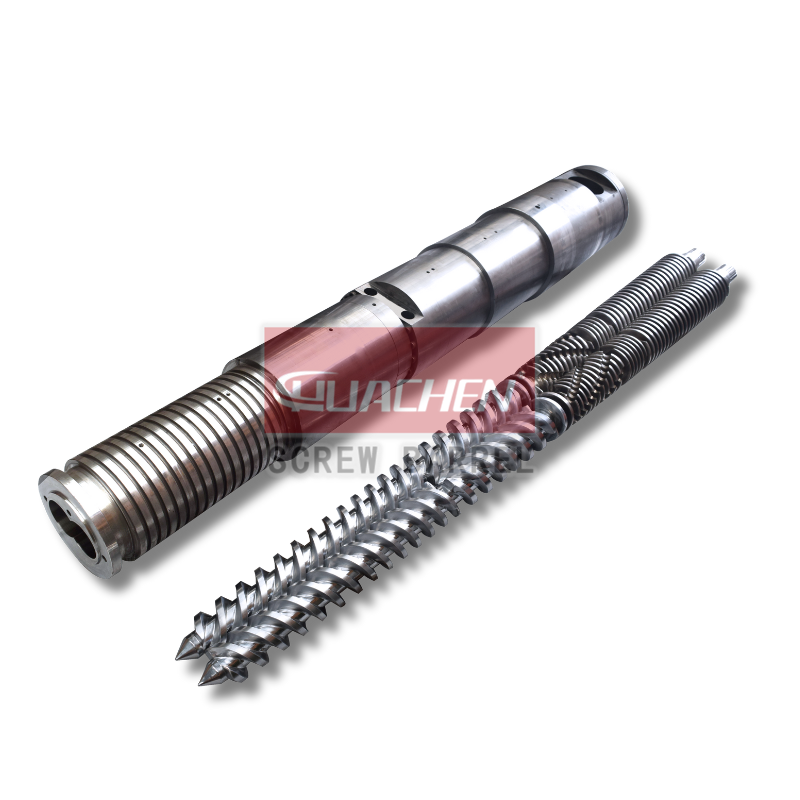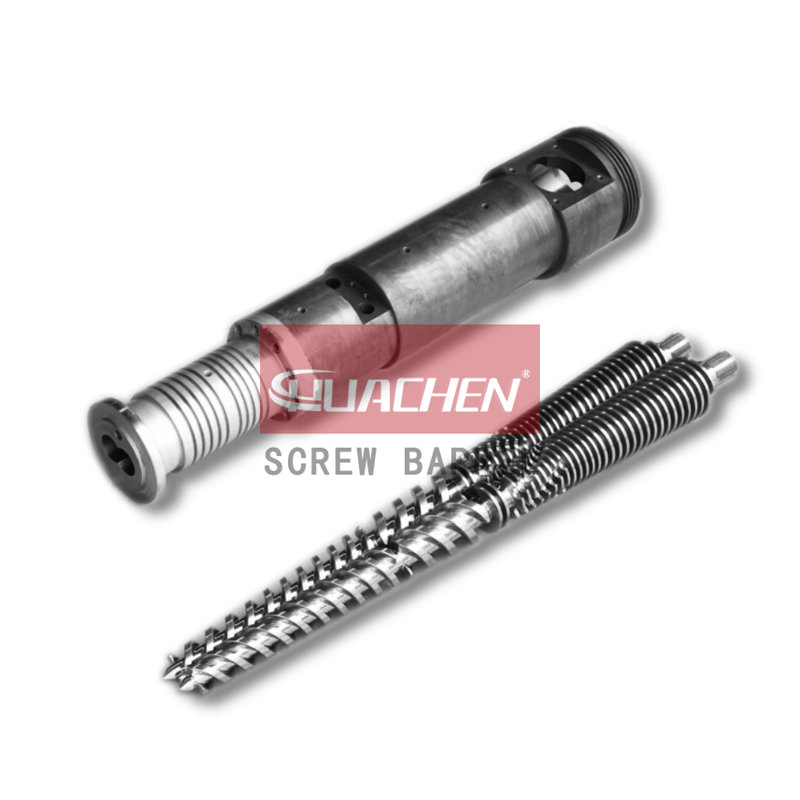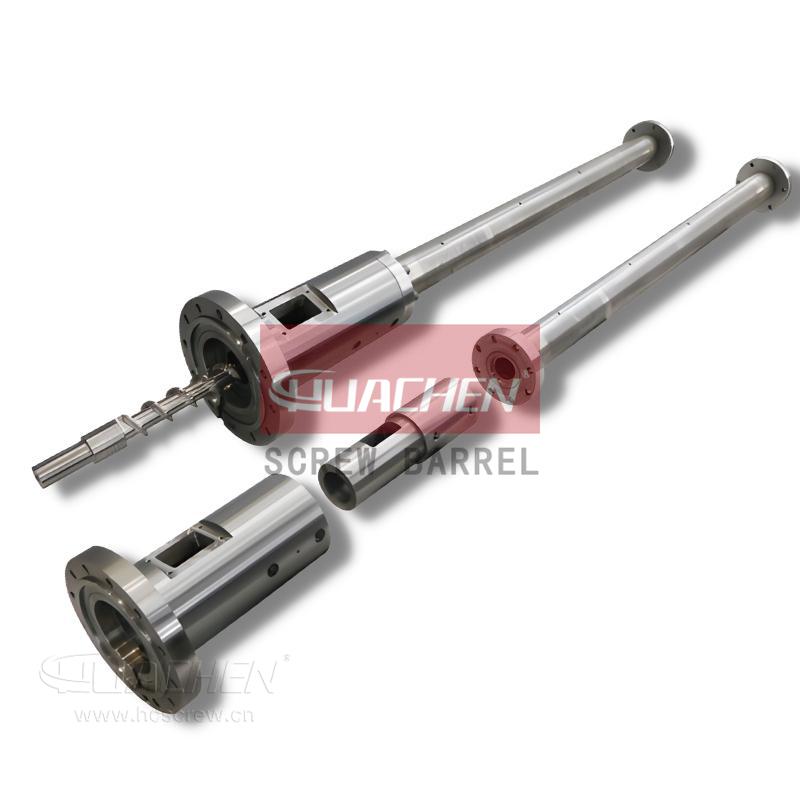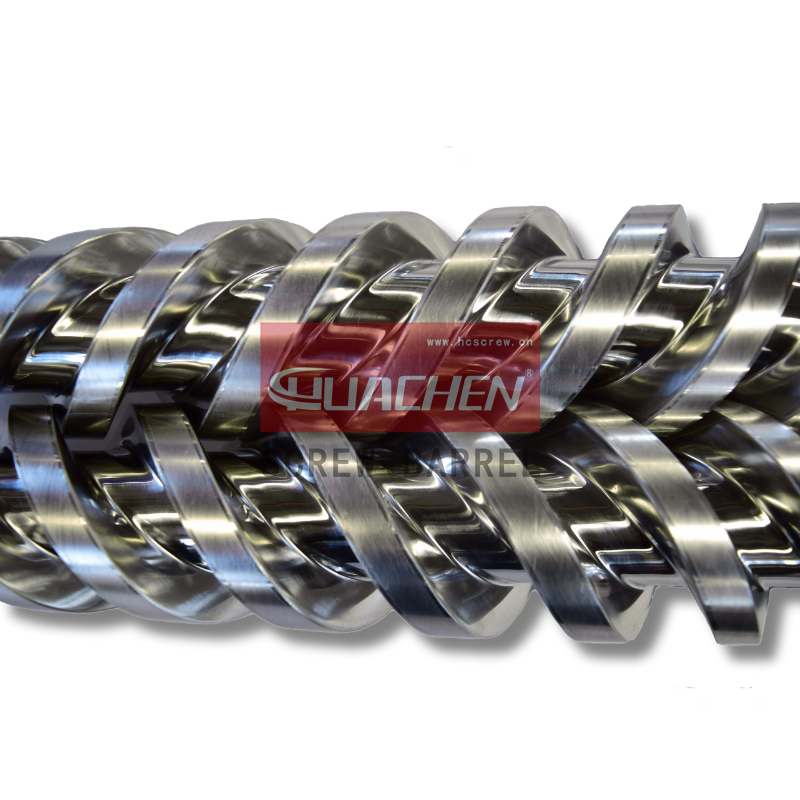6 Basic Functions Of Extrusion Screw Barrel Process
Date:2022-6-20 Author:hcscrew
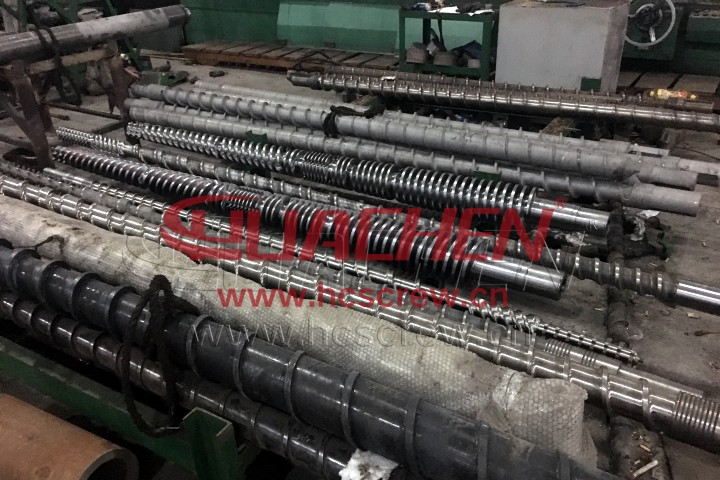
In the extrusion barrel, plastic is added from the hopper and forced in the direction of the head by the barrel threads. There is a gradual reduction in the volume between the threads as a result of the resistance of the filters installed in front of the barrel head, as well as the manifold and the die head.
As the plastic advances, the barrel heat source simultaneously exerts high pressure and heats it. Additionally, plastic undergoes compression, shear, and stirring forces. Friction between the screw and barrel, as well as friction between plastic molecules, also generates significant heat.
So, the plastic in the barrel gradually changes from a glassy state to a highly elastic state, and finally to a viscous flow state, reaching complete plasticization. This is due to the continuous rise in temperature.
Extrusion of plasticised material from the mouth of the head mold is carried out at equal pressure and speed while the screw continues to rotate. After cooling and shaping, the extrusion process is complete. Extrusion takes place on the screw, and the process consists of the following steps.
Functions 1: Feeding
In the extrusion parts hopper, plastic enters the screw groove either from its own weight or from a forced feeder. The screw prongs drive it forward. However, if the friction coefficient between the material and the metal hopper is too high, or the internal friction coefficient is too high, or the hopper cone angle is too small, bridging and hollow tube phenomena may develop. It will be necessary to stop the extrusion if the material cannot enter the screw trough smoothly. Consequently, if the extrusion productivity decreases abnormally or no material is discharged, a charge check is necessary. In some cases, the hopper design may need to be changed.
Functions 2: Conveying
Once the plastic enters the screw groove, it is conveyed forward one lead per rotation of the screw, which is known as the conveying rate 1. Nevertheless, the amount of forward conveying depends primarily on the friction factor fb of the plastic against the barrel and fs of the plastic against the screw. The larger the fb or smaller the fs, the more solid plastic will be transported ahead. According to numerous experiments, the friction factor of plastic against metal depends primarily on the temperature of the system and the roughness of the surface of the metal. Material movement speed and system pressure also have a relationship.
Functions 3: Compression
Compression of the plastic is absolutely essential during extrusion. Firstly, plastics are poor heat conductors, so any voids between the particles will directly affect their heat transfer and therefore melt rate. Only under increasing pressure along the screw does the gas between the pellets leave the hopper. If air bubbles form within the product, it will become inferior or scrap. Finally, the high system pressure also ensures that the product is relatively dense.
Three factors contribute to the generation of pressure on the screw:
1. In the structure, the extrusion screw groove’s depth decreases gradually, resulting in a gradual compression of the material.
2. In front of the screw head are a manifold, strainer, and die head.
3. Throughout the screw’s length, friction between the material and the metal generates pressure. The smaller the cross-sectional area of the head, the greater the pressure peak and the highest pressure point will move in the direction of the head. In general, peak pressure occurs at the front of the metering section or at the back of the compression section.
Functions 4: Melting
It is imperative to note that, as the pressure rises, the solid plastic in motion is constantly in contact and in friction with the heated barrel wall. The temperature of the plastic is continuously increasing as it approaches the melting point, forming a thin molten film on the inner wall of the barrel. This results in the use of two different sources of heat in order to melt the solid plastic. Due to the different speeds of movement of the layers, there are two types of heat. One is produced by conduction from the heater outside the barrel, and the other is produced by shear (internal friction) within the molten film.
When the molten film is thicker than the gap between barrel and screw prongs, the moving prongs scrape the molten film down. This forms a melt pool in front of the moving prongs. During the melting process, the melt pool becomes wider and the remaining solid becomes narrower and narrower until it eventually disappears. Tadmor published this groundbreaking theory in 1967, known as the melting theory.
Functions 5: Mixing
Extrusion involves compacting solid material under high pressure in order to form a dense plug. Mixing can only occur between layers of melt when there is relative movement between particles in the solid plug.
In general, the melt, particularly the melt transport section, exhibits the following mixing phenomena:
It is first necessary to disperse and mix the components of the material system uniformly. Components include resin and additives. Second, there is the mixing of heat. In the extrusion process, the first molten material has the highest temperature and the second molten material has the lowest temperature. Plastic melts at exactly the same temperature that it solidifies. Molten material extruded too early will result in unevenness in all parts of the extrudate. As a result, colour differences and deformation can occur, or the product may crack.
Also, since plastics themselves have a certain relative molecular mass distribution, mixing allows the higher relative molecular mass to be distributed evenly in the melt. Shear can also reduce molecular masses by breaking chains. By doing so, hard lumps and crystalline spots can be reduced in the final product. To ensure a homogeneous product, it is imperative to ensure that the melt transport section of the screw (the last section) is long enough. Melt transport is also known as homogenizing in the screw. To calculate the output of an extruder, one uses the volume of the screw groove in the final, equally deep section of the screw. The melting conveying section of a screw is also known as the metering section.
Functions 6: Venting
The extrusion process requires the venting of three types of gases.
One is the trapped air between the powder particles. This gas can generally be discharged from the hopper with gradually increasing pressure if the screw speed is not too high. However, if the speed is too high, the material might not be able to vent the gas in time, resulting in air bubbles in the product.
When heated, moisture adsorbed by the material from the air turns into water vapour. PVC, PS, PE, PP, etc., do not absorb much moisture and can discharge small amounts of water vapour simultaneously from the hopper. But for certain engineering plastics, like PA, PSF, ABS, and PC. There is not enough time for the water vapour to escape from the hopper due to too much moisture absorption.
The third type is some materials inside the plastic pellet, such as low molecular volatiles, low melting point plasticisers, etc. The heat generated during extrusion gradually vaporizes them. These gases can only escape when the plastic melts and overcomes its surface tension. At this point, however, they are already far away from the hopper and thus cannot be discharged through it. In this case, an exhaust extruder has to be used.
Clearly, an extrusion screw must perform the 6 basic functions of feeding, conveying, compressing, melting, mixing, and venting. Obviously, charging and conveying affect the output of the extruder. Compression, melting, mixing, and venting have a direct impact on the quality of the extruded product. The so-called quality here refers not only to the melt being complete but also to the density. Uniformity, and lack of air bubbles in the product. This is the quality of plasticisation.
Contact HUACHEN Screw Barrel Factory for more quotations and technical support for plastic extruder screw and barrel.
TAGS
HUACHEN Screw barrel recent post
- High-performance PVC Screw Barrel for Efficient Extrusion
- Durable Conical Twin Screw Barrel for Precision PVC Pipe Production
- High-Speed Screw Barrel for Increased Extrusion Efficiency
- Super Wear-Resistant Bimetallic Alloy Coating Screw Barrel for High Output Extruders
- High-Precision Parallel Twin Screw Barrel for Extrusion Excellence
- Top Quality Single Screw Barrels for Plastic Extrusion Applications
- High-quality Extruder Screw Barrel for Reliable Performance
- Efficient Plastic Extrusion Screw Barrel for Superior Output
conical twin screw barrel extruder screw barrel extrusion screw barrel Foam sheet processing high speed screw barrel HUACHEN SCREW news injection screw barrel parallel twin screw barrel pa screw barrel pe making formula pe screw barrel plastic fiber processing plastic fibre screw barrel Plastic film making screw barrel plastic pipe processing Plastic profile processing Plastic raw material knowledge pp screw barrel PVC making formula pvc screw barrel related parts for screw barrel screw barrel engineering work screw barrel knowledge single screw barrel twin screw barrel
;